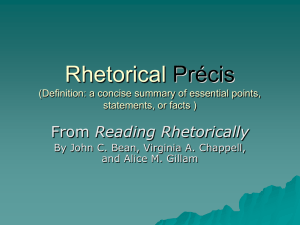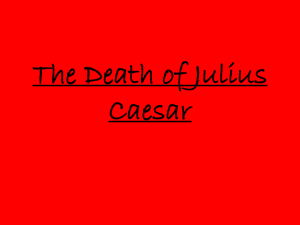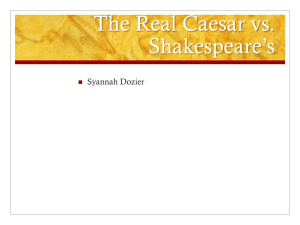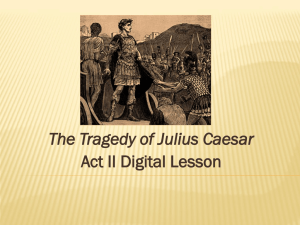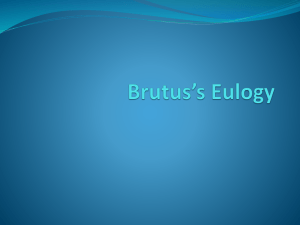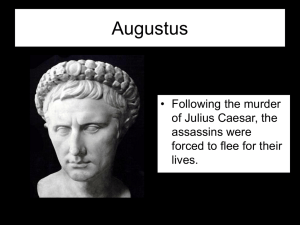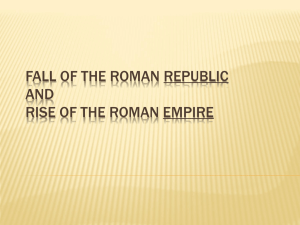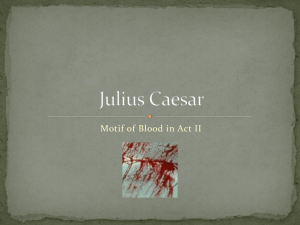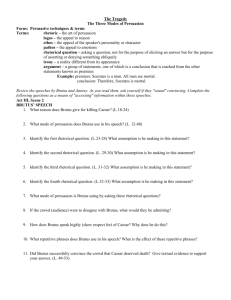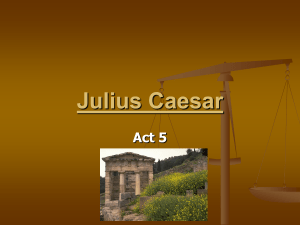File - John C. Tacapan
advertisement
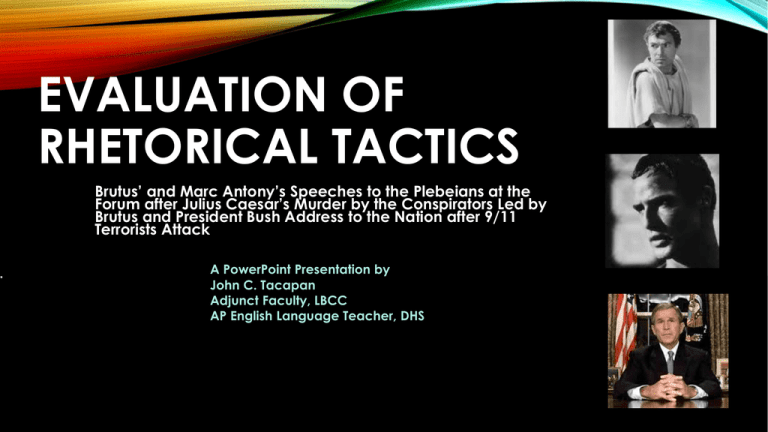
EVALUATION OF RHETORICAL TACTICS Brutus’ and Marc Antony’s Speeches to the Plebeians at the Forum after Julius Caesar’s Murder by the Conspirators Led by Brutus and President Bush Address to the Nation after 9/11 Terrorists Attack A PowerPoint Presentation by John C. Tacapan Adjunct Faculty, LBCC AP English Language Teacher, DHS COMMON CORE STATE STANDARDS Overview This specific lesson will be used to develop students’ abilities to evaluate information and viewpoints from diverse sources and formats, assessing credibility and accuracy, weighing premises and evidence, and developing an independent point of view. • Standards SL.11-12.2. Integrate multiple sources of information presented in diverse formats and media (e.g., visually, quantitatively, orally) in order to make informed decisions and solve problems, evaluating the credibility and accuracy of each source and noting any discrepancies among the data. • Standards SL.11-12.3. Evaluate a speaker’s point of view, reasoning, and use of evidence and rhetoric, assessing the stance, premises, links among ideas, word choice, points of emphasis, and tone used. OBJECTIVES • Students will explore the difference between the three classic rhetorical styles, ethos, pathos, and logos, evaluating how speakers establish (or lose) credibility, contrasting two speakers’ treatment of the same subject, and assessing stance, premises, links among ideas, diction, tone, and other features of the speaker’s argument. SUPPLIES NEEDED • Students should be provided with print copies of the three following speeches: Marcus Brutus, speech to the plebeians from Shakespeare’s Julius Caesar, Act III, scene ii. Marc Antony, speech to the plebeians from Shakespeare’s Julius Caesar, Act III, scene ii, President George W. Bush Address to the Nation, and Video of the three speeches: o Speech 1: Brutus (BBC Version) – speech starts at 3:15 and goes until approximately 7:27. Note: Speaker has bloody hands. Caesar’s (toga-shrouded) body is brought out and the toga is bloody. o Speech 2: Marc Antony (Marlon Brando) o Address to the Nation: President G. W. Bush ACTIVITY TWO • Be a Plebeian! In this activity, students will evaluate the effectiveness of two different speakers, both of whom have come to speak about the same subject: the murder of Gaius Julius Caesar. Those who have read and who have seen Julius Caesar will be familiar with these speeches, but previous knowledge other than background (presented in the following slides) is not necessary for this exercise. BACKGROUND • Julius Caesar was one of the most successful generals and politicians of ancient Rome, a society that prided itself on having liberated their nation from the tyranny of monarchy – much like America itself does with reference to Great Britain. Rome prided itself on being a republic, a nation in which citizens of Rome could have a voice in public office and be represented in government. Romans feared a return to monarchy, but monarchy was essentially what Caesar represented. • After Caesar triumphed in Gaul and emerged as the victor in a successful struggle for power against Pompey Magna, his political rival, he returned to Rome as an (essentially) unopposed leader, a “Dictator Perpetuus” (Dictator-for-life). • However, this assumption of complete power truly disturbed many prominent Roman senators, among them Marcus Junius Brutus, a man whose ancestors had helped to overthrow the last of the old kings of Rome – the equivalent, in America, of having been a Revolutionary War hero fighting King George III. Though Caesar thought highly of him and trusted him, Brutus was convinced to conspire in Caesar’s assassination, which took place on the Ides of March (March 15) in 44 BC. As Caesar entered the Senate, he was surrounded by a group of sixty senators and stabbed approximately 23 times. • These speeches, from Shakespeare’s play Julius Caesar, occur immediately after the death of Caesar. The first to speak is Brutus; the second is Marc Antony, Caesar’s second-in-command. Both men speak to the plebeians, the common people of Rome, who had loved Caesar and who had been instrumental in his political success. Though the members of the conspiracy are reluctant to allow Antony time to speak, Brutus permits it on the condition that Antony maintains the idea that the senators are honorable men and have acted honorably. READING THE TRANSCRIPT AND VIEWING OF ACT 3 SCENE II SPEECHES OF BRUTUS AND MARC ANTONY • Hard copy of Act 3 Scene II of Shakespeare’s Julius Caesar • Refer to jctacapan.weebly.com for the videos. STUDENTS’ ACTIVITY Watch the video carefully, noting the following elements in the speakers’ speeches and write down your impressions and answers to the questions while the video is still fresh in recollection 1. What is the speaker’s primary mode of appeal? 2. What is the speaker’s goal? What does he wish to occur as a result of this speech? 3. What is the speaker’s argument? 4. What reasons does he offer for his argument being right? 5. Identify at least two different tones with which this speaker speaks. Why does he use this tone? Why does he change it? 6. What rhetorical tactics – appeals to pathos, logos, ethos, or other rhetorical tools – does the speaker use? 7. Are these tools effective? Ineffective? Why? 8. What points or ideas does this speaker particularly emphasize? 9. Why does he emphasize those points and not others? 10.What links between ideas does this speaker create or emphasize? 11.Do you find him convincing? Why or why not? 12.How credible is this speaker? 13.What is his bias? 14.Does his bias invalidate or compromise the validity of his argument? SMALL-GROUP AND WHOLE-CLASS DISCUSSION • After you have had sufficient time to evaluate both speakers, compare your answers before discussing both speeches in a whole group. The primary question which should define the whole-group discussion should be the essential one: What elements in Antony’s speech made it the more successful of the two? Why did Brutus’ fail? CONCLUSION AND ASSESSMENT • At the end of the discussion period, you can come to closure about the methods of persuasion you have seen used in the two Caesar speeches by applying your understanding of persuasive techniques, logical links, point of view, bias, and use of rhetorical tools to an analysis of the famous speech by President George W. Bush, “Address to the Nation” PROMPT In a forcefully-argued essay, evaluate the following elements of Bush’s speech and argue whether his speech effectively conveyed the speaker’s message – and why. In your essay, please account for or address all of the following: • The speaker’s use of ethos, pathos, logos (with examples) • The speaker’s bias or stance The speaker’s main message or point • The speaker’s goal • The premises of his argument (that is, the reasons he offers to explain why he is right) • His use of reasoning – what basic reasoning does he offer? • What elements is he particularly emphasizing? Identify at least two different tones used in this speech. Why is this tone effective (or not)? • Why does the speaker change from tone A to tone B? • Did you find the speech persuasive or effective? Why or why not?
